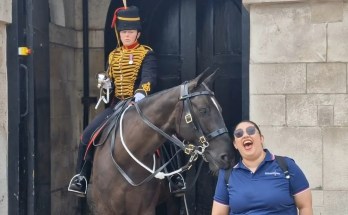In a startling incident in central London, a tourist fainted after being bitten on the arm by a King’s Guard horse. The event took place outside the Household Cavalry Museum, a popular spot where tourists eagerly gather for photo opportunities with the iconic guards and their majestic horses. The scene was typical of a busy day, with numerous visitors surrounding the guard and his horse, each hoping to capture a memorable photograph.
The horse, however, seemed agitated by the constant attention. It repeatedly turned its head and nipped at those who got too close, clearly indicating its discomfort. Among the eager crowd was a woman dressed in a black baseball cap and a Pink Floyd t-shirt. Ignoring a prominent sign that read, “Horses may kick or bite,” she quickly positioned herself next to the horse. The animal, not hesitating, bit her on the arm. The woman let out a loud squeal and rushed back to her friends, while the surrounding crowd watched in stunned silence.
Her companions immediately attended to her, inspecting the bite wound. One man attempted to clean the bite mark with a cotton bud. Despite their efforts, the woman’s condition deteriorated rapidly. She appeared to waver in and out of consciousness before collapsing completely to the ground. In a separate video, her friends are seen fanning her as she lies against a gate, trying to revive her. In a rare move, the King’s Guard, using his sword, signaled to a cameraman and requested, “Can you go and get the police officer?”
As officers arrived to assist the injured woman, tourists continued to swarm around the guard and his horse. Some visitors even attempted to pet the unsettled animal, seemingly undeterred by the recent incident. Despite being on duty, the King’s Guards frequently encounter dangerous interactions with the public. Numerous signs around the area warn visitors of the potential risks, but many still approach the horses, often at their own peril.
This incident is not an isolated case. Last month, another tourist outside Buckingham Palace experienced a similar fate. She was seemingly headbutted by a King’s Guard horse, causing her to fall dramatically to the pavement. Video footage captured the moment a curly-haired woman stood smiling next to a black horse, posing for photos, before the horse nudged her. The woman fell face down, her bag flying away, as the gathered crowd gasped in concern.
In May, another incident involved a King’s Guard horse biting a tourist who had touched the animal while posing for a photo. The video, which went viral on social media with over 855,000 views, showed the woman placing her hand on the horse’s neck. The horse reacted by swinging its head towards her and biting down on her saree. Earlier this year, in January, yet another tourist faced a similar experience when a King’s Guard horse bit her arm and aggressively tugged on her black puffer jacket as she posed for a photo.
These repeated incidents highlight a significant issue: despite their reputation as tourist attractions, the King’s Guard are elite soldiers with the primary duty of protecting the monarch and her properties. These guards are generally not permitted to interact with the public. They may shout warnings or present their bayonets if they feel threatened or if someone gets too close. They are also prohibited from leaving their posts, even for toilet breaks, during their two-hour shifts, and will march through anyone obstructing their path.
While the guards and their horses are undoubtedly a fascinating sight, these incidents underscore the importance of respecting the boundaries set for the safety of both the public and the animals. Visitors must heed the warnings and maintain a respectful distance to prevent further accidents and ensure a safe experience for everyone involved.










